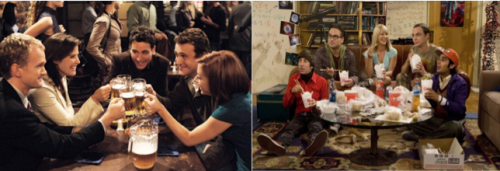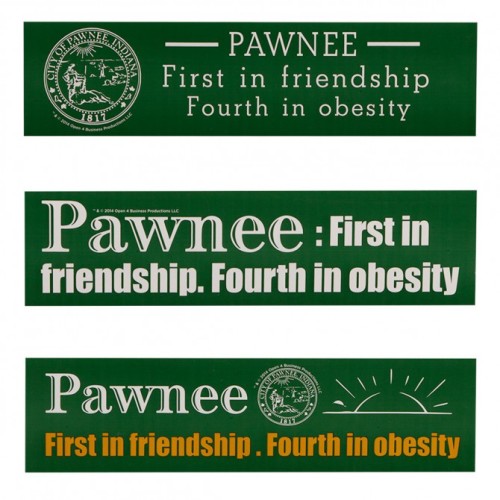
This guest post by Stephanie Brown appears as part of our theme week on Fatphobia and Fat Positivity.
Trevor Noah, heir to The Daily Show throne, recently came under fire for some fat jokes, (among others) that he made on Twitter, demonstrating once again that fat jokes, especially about women, have long been a staple of the comedy writer’s toolbox. Critics of Noah seem to forget that Jon Stewart and Stephen Colbert have been making jokes about Chris Christie’s weight for years, a disturbing trend that NPR’s Linda Holmes beautifully addressed in an essay last year. You would think Christie’s policies and actions as governor would provide more than enough material for satire, but comics have found that using fatness as a punch line is a reliable way to get cheap laughs.
Sitcoms, too, have frequently been guilty of using “fat” as a punch line. From Monica’s fat-suit flashbacks on Friends, to Mike and Molly’s poking fun at its main characters, to the Seavers’ constant ribbing of Carol about her weight on Growing Pains (made more disturbing by the fact that Tracy Gold suffered from a serious eating disorder), sitcoms have long made fun of characters for taking up too much space on screen. Often characterized as a moral failing, fatness is policed through ridicule. Such jokes tend to rely on the mere presence of an overweight character to generate laughs.

Several sitcoms, however, rely not on the on-screen presence of a so-called “unruly body,” but rather on the imagined image on an off-screen one. For instance, on NBC’s Will and Grace, Grace’s sidekick Karen consistently rattles off one-liners about her obese husband Stan. CBS’s The Big Bang Theory (2007-) continues in this tradition with its recurring jokes and storylines about Howard Wolowitz’s mother.

Howard is an engineer turned astronaut who lives for a majority of the series with his overbearing mother. The difference between Stan and Mrs. Wolowitz is, of course, that we hear Howard’s mother, played by the recently deceased actress Carol Ann Susi. Howard obviously loves his mother, despite their constant bickering, and the show deals with the death of both the actress and the character very poignantly. Regardless of any underlying affection toward Mrs. Wolowitz, though, the show generally mines humor from descriptions of her unseen obesity.
Throughout the course of the The Big Bang Theory, Mrs. Wolowitz’s weight provides an easy punch line for Howard and his friends. In “The Hawking Excitation” (5.21), Sheldon apparently sprains his wrist helping Howard’s mom into a dress when he takes her clothes shopping. Earlier in the series in “The Engagement Reaction”(4.23), Penny reacts with disbelief to Howard’s story of lifting his mother in order to take her to the hospital, joking that Mrs. Wolowitz’s own legs could barely lift her up. Not only is Mrs. Wolowitz characterized by her weight, she is also described as an overbearing, gluttonous nag. In her character we see the ways in which obesity is tied to morality and humanity, or rather, a lack thereof. And, because she never appears on screen, the audience is free to imagine an even more extreme version of this stereotypical character.
Notably, Mrs. Wolowitz appears briefly on screen during “The Spoiler Alert Segmentation” (6.15), walking back and forth through a doorway behind Raj while he sits in the dining room. Her appearance is meant to work as a sight gag not only because the audience has never seen her, but also because the mere presence of an overweight body is reason enough to laugh.

While CBS’s How I Met Your Mother (2005-2014) doesn’t have a defined invisible fat character to use as a punching bag, the show is similarly permeated by fatphobia. The series, centering on a group of five friends in New York City navigating their late 20s and early 30s, is told from the perspective of the show’s main character, Ted Mosby. For a show that was often wonderfully smart, funny, and sweet, the writers’ strange obsession with making fun of fat women was often infuriating and frequently baffling, as others have noticed and written at length about.
While most of the show’s characters get in a “fat chick” joke at some point during the show’s run, most of the fat panic stems from Barney, the show’s resident bro-y bachelor. While the audience was likely originally meant to read Barney as an entitled, misogynist jerk, because he’s played by likeable human Neil Patrick Harris, the argument that we’re meant to be disgusted by Barney’s behavior rings hollow. Indeed, this site has previously written about the show’s unsettling misogynistic streak.

Like his misogyny, Barney’s fat jokes span the entirely of the series. He feels the need to constantly assert that he doesn’t have sex with fat women, in one instance making his friends swear a “broath” not to interfere with his life unless “unless it is a matter of health, national security or I’m about to get up on a fattie” (“The Broath,” 7.19). He also feels the need to warn his friends not to have sex with fat women. In the season three episode “Third Wheel” (3.3), he makes sure the combined weight of the ladies Ted is about to have a threesome with is “under 400 pounds.” If that weren’t enough, he frequently makes proclamations that no one should have sex with fat women:
Minister: If you want to get married in my church, you’ll stop breaking the ninth commandment.
Barney: Uh, no fat chicks?
Minister: Thou shalt not lie!
Barney: With fat chicks?
(“Knight Vision, “ 9.06)
Rather than punish him for his sociopathic, misogynistic conduct, the show rewards Barney with clever one-liners and fancy suits.

His friends make half-hearted attempts at condemning his behavior, but even they join in on the show’s the panoply of fatphobia, like when Marshall tells Barney that he “sounds like a fat girl on Valentine’s Day” (“Not Father’s Day,” 4.7). Even Lily and Robin often join in gleefully mocking other women. This includes, of course, making fun of the mere idea of fat women. Robin joins in with Marshall and Barney in this lovely exchange after Ted tells them about a wealthy architecture client:
Marshall: He’s rich? Please tell me he wrote you a big, fat check. A check so fat, it doesn’t its shirt off when it goes swimming.
Barney: That is a big, fat check. A check so fat, after you have sex with it, you don’t tell your buddies about it.
Robin: A check so fat, when it sits next to you on an airplane, you ask yourself if it should have bought two seats.
(“Fast As She Can,” 4.23).
Like the characters in The Big Bang Theory, Barney and his friends don’t direct their cruelty at a visible person. They don’t direct their jokes at any specific person at all, but rather at all fat women. Their jokes construct fat women not as people with feelings let alone family, friends, or lovers. They’re either a joke or a disembodied threat to the main characters’ sexual pride. Nameless, faceless, and bodiless, these imagined, invisible women are, like Mrs. Wolowitz, treated as less than human.
An addendum to this point is the way the show treats one of the only fat characters, Robin’s co-worker Patrice. Patrice’s main function on the show was to be yelled at by Robin for no reason and, eventually, to act as Barney’s fake girlfriend so he can convince Robin that he has changed his philandering ways and is now marriage material.

This particular storyline shows us, once again, that a fat character’s only function is to act as comic relief and to help the traditionally attractive main characters find love. She may be visible, but her visibility is conditional on performing the one-dimensional supportive friend that so many underdeveloped, potentially interesting fat characters have before been relegated. As Michael Arbieter of Hollywood.com noted about the storyline:
“We can’t be left to forgive Barney and How I Met Your Mother, to subjugate and marginalize Patrice. The fact that we’re asked to do this so cavalierly is frightening.”
Indeed, the casualness and frequency with which the characters make fat jokes on The Big Bang Theory and How I Met Your Mother, two series that frequently deal with themes of friendship and belonging, imbues them both with an unnecessary cruelty. While fat jokes are often wielded as a way police on-screen bodies, the ridiculing of absent bodies even further objectifies fat people. By not even giving the audience a chance to identify with the character or characters being ridiculed, all subjectivity is, in essence, taken away. Such erasure tells the audience, yet again, that thinness is the price of admission to our television sets. Not only are these characters deserving of ridicule based on their appearance, their appearance is so distasteful as to be banished from the screen.
As we’re reminded by anonymous online harassment or something as simple as talking badly about an absent friend, distance and invisibility often enable cruelty.

While film and television have historically mistreated and relegated fat characters to supporting status, How I Met Your Mother and Big Bang Theory push their fat characters completely off screen. Such distancing brings the process of dehumanization to its natural conclusion, allowing fat-phobia to rage unchallenged.
As Lily once tells Ted, “If there’s one thing you never do, it’s call a woman fat right to her face!” (“The Mermaid Theory,” 6.11). Otherwise, you might actually have to take responsibility for those words.
Stephanie Brown is a television, comedy, and podcast enthusiaist working on her doctorate in media studies at the University of Illinois, Urbana-Champaign.






